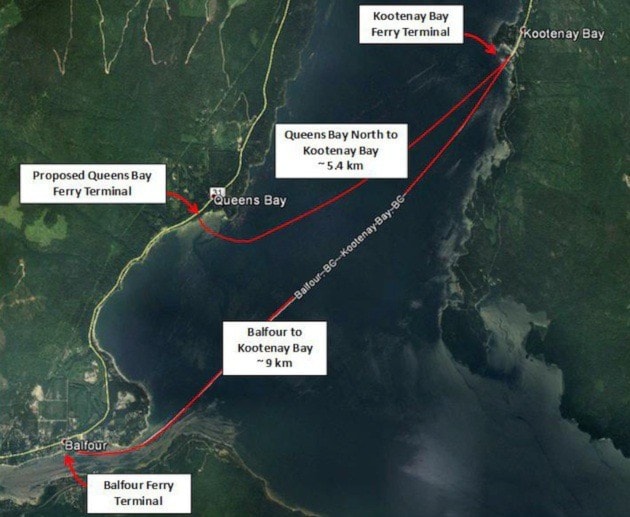A feasibility study on moving the Kootenay Lake ferry’s western terminal concludes that constructing a new location on the north side of Queens Bay would cost $25 million, compared to $36 million to $40 million to upgrade the current Balfour location and build a new ferry.
The report by engineering firm SNC-Lavalin was completed for the Ministry of Transportation in March and posted on the government’s website this week ahead of an open house set for Wednesday from 5 to 8 p.m. at Redfish school. The full document is attached at bottom.
The study found “the relocation of the Balfour ferry terminal to Queens Bay North was not only technically feasible, it was a superior choice when critically compared under the categories of safety, service, community/stakeholder impact, environmental impact and financial.”
The present site “in its existing state is not sustainable, and even with several improvements, many safety issues will not be significantly improved.”
The study laid out a timeline suggesting the project could be completed in 44 months, including construction of a new terminal over two summers.
However, it recommended an archaeological impact assessment, as the preferred site has “moderate to high potential” for buried archaeological deposits and prehistoric burials.
The report outlines a series of challenges to navigating through the West Arm, including:
• Shifting stand deposits in the West Arm are creating low clearance for navigation;
• A limited draft during low water resulting in coating breakdown and pitting on the bottom of the MV Osprey 2000 as well as propeller damage;
• An increased risk of accidents during the summer due to a larger number of pleasure boats.
It also lists problems at the terminal itself: vehicles overflow onto the highway shoulder during peak periods and the intersection lacks exit lanes and dedicated turn lanes for westbound traffic.
The study considered four potential alternate sites in Queens Bay and ruled out two, leaving two others to be evaluated against the existing terminal in terms of safety, service, community impact, environmental, and financial considerations.
The preferred site is near McEwen Point, a location the report says would allow for hourly sailings using the Osprey, since the crossing distance to Kootenay Bay would be reduced from the present nine kilometers to 5.4.
Currently the wait between sailings from June to September is 50 minutes, when both the Osprey and MV Balfour are in service. The rest of the year, when the Osprey flies solo, sailings are an hour and 40 minutes apart. The crossing itself takes 35 minutes, of which 10 are spent navigating in and out of the narrows.
The report cast doubt on the future of the 62-year-old Balfour, stating that it “was not originally designed to meet current federal regulatory safety requirements and given its age, it is experiencing increasing operating costs. The MV Balfour must be retired within the next few years.”
Without a second vessel, the report said, the Osprey can’t meet current peak demands sailing from Balfour. A new ferry would cost an estimated $30 million.
 Discussion guide poses questions
Discussion guide poses questions
A new landing at Queens Bay (pictured above in a concept drawing) would hold 160 vehicles while the access road from Highway 31 could accommodate 60 more, the report says. The present compound at Balfour accommodates 110.
The Queens Bay site, including the access road and compound, is all on undeveloped Crown land. Two private properties are along the shoreline to the northeast, within 200 meters of the proposed loading platform. The report says the ministry “would need to consider potential impacts to these properties in the design development phase.”
If the ferry remains at Balfour, the report says, it would cost $1 million to acquire additional right-of-way to accommodate vehicle line-ups, although safety would only improve marginally. Expanding the vehicle area by paving over the rest area would cost another $2 million, and dredging and widening the channel would cost an estimated $3 million, and be an ongoing requirement. The major cost, however, would be a new ferry to replace the Balfour, bringing the total price tag to $36 million or more.
A new Queens Bay terminal is estimated at $25 million, but the breakdown of how that figure was arrived at is blacked out in the public copy of the report. It would be built on fill and require one-time dredging.
The report concludes that “relocating the terminal to Queens Bay North will significantly improve highway and marine safety. In addition the service level will be significantly improved by the shorter water route.”
The consultant said it was unaware of any “critical habitat or sensitive species” that would preclude moving the terminal but acknowledged “a detailed field investigation could identify environmental attributes that would require specific consideration or protection.”
It also said that by definition, the proposed terminal would permanently alter fish habitat, so a formal plan to offset those losses would be needed.
Although several businesses are immediately adjacent to the Balfour terminal, preliminary sketches of the Queens Bay site don’t include any provision for them.
A “discussion guide” posted on the government’s website acknowledges that while the feasibility study examines technical, safety, and financial perspectives “it does not evaluate the full range of impacts on the community.”
The guide poses several questions that it says require community consultation: “If the terminal is relocated, there will be impacts on business and amenities that have developed around the terminal. How will these impacts be addressed? If the terminal is relocated, what will happen to the Balfour ferry terminal property?”
The Kootenay Lake ferry is operated by Western Pacific Marine under contract with the provincial government, which owns the ferries.
Balfour has been the western terminal since 1947 but the idea of moving it to Queens Bay was previously studied in 1990, 1996, and 2012.
The public consultation period runs through July 6, with a decision expected in the fall.
